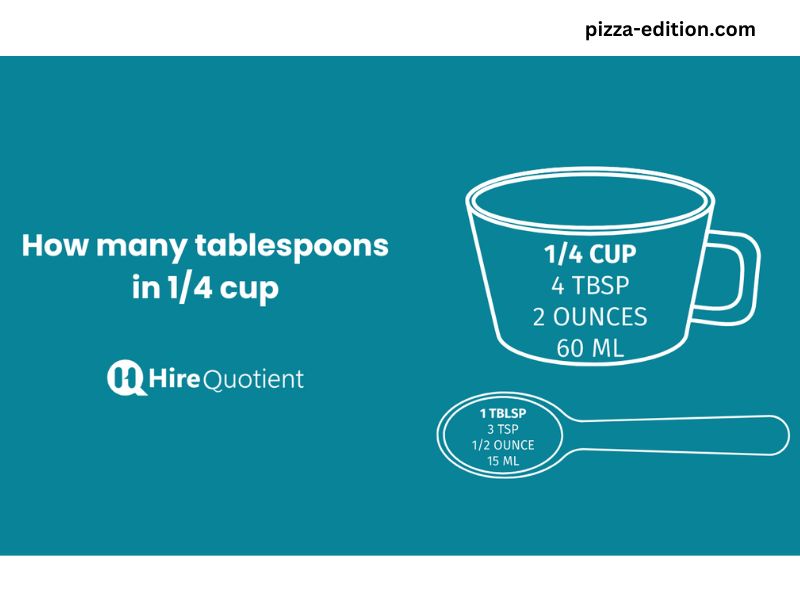In the culinary realm, precise measurements are the foundation of successful recipes. Whether you’re a seasoned chef or a budding home cook, understanding the intricacies of kitchen measurements is crucial. From cups and tablespoons to ounces and milliliters, each unit serves a specific purpose in ensuring consistent and delectable results.
One of the most common conversions encountered in recipes is between cups and tablespoons. These two units are widely used in both baking and cooking, making it essential to grasp the relationship between them. By mastering this conversion, you’ll be able to seamlessly adapt recipes, adjust serving sizes, and confidently follow instructions without any guesswork.
In this comprehensive guide, we’ll dive deep into the question, “How Tablespoons in 1/4 Cup?” and explore the broader topic of measurement conversions in the kitchen. Whether you’re a novice cook seeking clarity or an experienced culinary enthusiast looking to solidify your knowledge, this article will provide you with the insights and tools you need to navigate the world of kitchen measurements with ease.
Converting between cups and tablespoons
Before delving into the specific conversion of 1/4 cup to tablespoons, let’s establish a foundational understanding of these two units. Cups are a volumetric measurement used primarily for dry and liquid ingredients, while tablespoons are a smaller unit typically employed for measuring smaller quantities or adding flavors and seasonings.
The conversion between cups and tablespoons is based on a simple ratio. One cup is equivalent to 16 tablespoons. This means that every time you measure one cup of an ingredient, you’re essentially measuring 16 tablespoons of that same ingredient.
It’s important to note that this conversion applies to both dry and liquid ingredients, although the accuracy may vary slightly due to factors such as ingredient density and consistency.
How Many Tablespoons in 1/4 Cup?
Now, let’s address the central question: “How Many Tablespoons in 1/4 Cup?” Since one cup is equal to 16 tablespoons, we can deduce that 1/4 cup is equivalent to 4 tablespoons.
To break it down further:
- 1 cup = 16 tablespoons
- 1/4 cup = 1/4 of 16 tablespoons = 4 tablespoons
This conversion is particularly useful when adjusting recipes or scaling them up or down to accommodate different serving sizes. By knowing that 1/4 cup equals 4 tablespoons, you can easily modify the quantities of ingredients without compromising the recipe’s integrity.
Other common conversions in cooking
While the conversion between 1/4 cup and tablespoons is a fundamental one, there are numerous other common conversions that every cook should be familiar with. Here are a few examples:
- 1 cup = 8 fluid ounces
- 1 tablespoon = 3 teaspoons
- 1 ounce = 28.35 grams
- 1 pound = 16 ounces
- 1 liter = 1000 milliliters
Familiarizing yourself with these conversions will not only enhance your culinary skills but also allow you to seamlessly adapt recipes from different sources and measurement systems.
Tips for accurate measurement conversions
Accurate measurement conversions are crucial in cooking, as even slight deviations can significantly impact the outcome of a dish. Here are some tips to ensure precise conversions:
- Use proper measuring tools: Invest in a set of high-quality measuring cups and spoons designed specifically for cooking. Avoid using household cups or spoons, as their measurements may not be accurate.
- Level off ingredients: When measuring dry ingredients, use a straight edge to level off the top of the measuring cup or spoon. This ensures consistent measurements and prevents overpacking or underpacking.
- Consider ingredient density: Keep in mind that the density of ingredients can affect the accuracy of volumetric measurements. For example, a cup of flour may weigh differently than a cup of sugar due to their varying densities.
- Double-check conversions: Before proceeding with a recipe, double-check your conversions to avoid any mistakes. It’s better to take an extra moment to verify your calculations than to risk an unsuccessful dish.
- Use conversion charts or tools: Refer to reliable conversion charts or online tools to ensure accurate conversions between different units of measurement.
Using measurement conversion charts and tools
While memorizing common conversions is helpful, having access to comprehensive conversion charts or online tools can be a game-changer in the kitchen. These resources provide a centralized reference for a wide range of measurement conversions, ensuring accuracy and eliminating the need for mental calculations.
Many reputable cooking websites and apps offer free conversion charts or built-in calculators, making it easy to convert between different units of measurement with just a few clicks or taps.
Additionally, there are dedicated conversion apps and websites specifically designed for cooking and baking, offering advanced features such as ingredient-specific conversions and the ability to save custom conversions for future reference.
Converting between other units of measurement
While cups and tablespoons are commonly used in recipes, it’s essential to be familiar with conversions between other units of measurement as well. Here are a few examples:
- Weight measurements: Ounces, grams, and pounds are often used for measuring ingredients like meat, cheese, and certain baking ingredients.
- Liquid measurements: Fluid ounces, milliliters, and liters are used for measuring liquids like water, milk, and oils.
- Temperature measurements: Fahrenheit and Celsius are used to measure oven temperatures, water temperatures, and other temperature-related cooking instructions.
Mastering these conversions will not only expand your culinary repertoire but also allow you to confidently work with recipes from different regions and cultures that may use different measurement systems.
Converting recipes for different serving sizes of Tablespoons in 1/4 Cup
One of the most common challenges in cooking is adjusting recipes to accommodate different serving sizes. Whether you’re cooking for a larger crowd or scaling down a recipe for a smaller gathering, understanding measurement conversions is crucial.
Let’s consider an example: You have a recipe that serves four people, but you need to make it for six people. To adjust the recipe, you’ll need to convert the measurements accordingly.
If the original recipe calls for Tablespoons in 1/4 cup of an ingredient, you know that 1/4 cup is equal to 4 tablespoons. To increase the serving size by 50% (from four to six), you’ll need to multiply the original measurement by 1.5.
- Original measurement: 1/4 cup (4 tablespoons)
- Conversion factor: 1.5 (to increase by 50%)
- New measurement: 1/4 cup × 1.5 = 3/8 cup = 6 tablespoons
By understanding measurement conversions, you can easily scale recipes up or down to accommodate different serving sizes, ensuring that the flavors and textures remain consistent.
Exploring different measurement systems Tablespoons in 1/4 Cup
While the cup and tablespoon system is widely used in the United States and some other countries, it’s important to recognize that different measurement systems exist around the world. Understanding these systems can be particularly useful when working with international recipes or traveling to different regions.
For example, the metric system is widely used in many parts of the world, employing units such as grams, milliliters, and liters. Familiarizing yourself with conversions between the metric system and the cup/tablespoon system can open up a world of culinary possibilities and allow you to explore a diverse range of recipes from different cultures.
Additionally, some countries use unique measurement systems specific to their culinary traditions. For instance, in Japan, measurements like “go” and “shaku” are commonly used in traditional recipes. Embracing these diverse measurement systems can deepen your appreciation for global cuisines and broaden your culinary horizons.
Conclusion
Mastering the conversion between Many Tablespoons in 1/4 Cup and tablespoons is a foundational step in understanding kitchen measurements. By grasping this essential conversion, you’ll be better equipped to navigate recipes, adjust serving sizes, and confidently execute culinary creations.
However, measurement conversions extend far beyond just cups and tablespoons. Familiarizing yourself with conversions between various units, such as ounces, grams, and milliliters, will further enhance your culinary skills and open up a world of possibilities in the kitchen.
Remember, accuracy is key when it comes to measurement conversions. Invest in proper measuring tools, double-check your calculations, and refer to reliable conversion charts or online tools when needed. With practice and dedication, these conversions will become second nature, allowing you to focus on the true art of cooking and creating delectable dishes for yourself and your loved ones.




